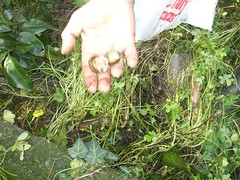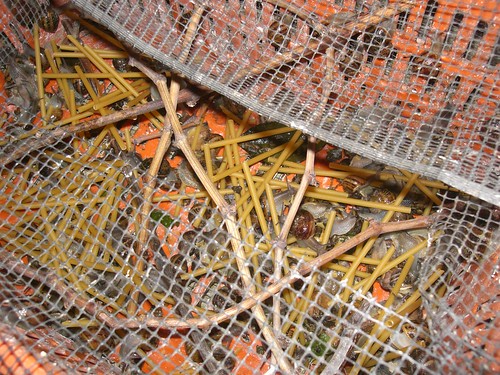Snails are a Cretan delicacy - they're not as popular in other parts of Greece as they are in Crete, and the snails sold in Athens are probably being brought by ex-patriate Cretans. Most people think of them as disgusting garden pests. But as soon as you call them 'escargots', all sorts of positive connotations spring to mind - 'chic' food, haute cuisine, exotic taste. If you just want to find out what they taste like, then all you need to do is boil up a dozen and season them. Just think of them as land shellfish, as Ric commented.
Once you've tried them, if you like them enough, you may want to harvest them - they make an interesting appetiser at a dinner party, individually served (5-10 per bowl) in olive oil, or as the French do their escargots, in garlic butter sauce. In my house, we cook them in a tomato-based stew. The only weird thing about the way the French cook them is that they remove them from their shells, and then refill them after marinating them in a sauce, a time-consuming, pointless process, since they will once again be removed to be consumed. The number of times they are handled by man must spoil their taste, not to mention their hygiene. Then again, special cutlery has been invented to extract the snail out of the shell; this is never used in Greece. We use our forks, and we're not averse to cracking the shell when things get tough, or slurping on it to get what we want!
Snails have been eaten for many centuries in Greece and other parts of Europe. The snails of the Old Countries are probably older relatives of the same ones as the snails found in the New World, originally stowing away on ships and exported produce, as Lulu mentioned (but then maybe not - see the comments section). It amazes me that the photograph of the common garden snail found in Wikipedia is exactly the same as the most common village snails we find in our village fields in Fournes.




We harvest snails in the spring (and sometimes in the summer, up to the end of July) from our orange groves. You have to know your area well enough to know where the snails hide. I've been doing this for about five years, so I have an idea where they keep home in Fournes. When it rains, snails 'walk around' in the damp foliage; they leave their territory and perambulate the area. Once the rainy damp period stops - here in Hania, this is usually end of May, early June at the latest - they hibernate; they are summer sleepers. In Crete, we say 'stoumbonoun' (they puff up and stay put). And I know just where they do that in the village.
On an early morning day in mid-May, the weather was very damp. We decided to forage for snails, but when we looked int heir usual place of residence, they weren't there. We hung around the fields doing other jobs, and as the day warmed up, the snails came back to their 'home'. When we ready to leave the field, we looked for them in the same places - under rocks that don't get a lot of sunlight, in the thickets of grassy bushes, dry spots under irrigation hoses, on the walls of old disused concrete irrigation canals - just waiting for us to come. If you collect them during the rain, as many villagers do here in Hania, you will practically be stepping on them! I've been advised to collect only large snails, as they are meatier, and small ones obviously haven't reached the stage of maturity that they need to be consumed. Their shell cracks more easily at th cooking stage if they are too young. There is another logic to this: leaving smaller ones in the field means that they will not become extinct or be depleted, and will continue to reproduce.
The snails were put into a container that allows them to breathe - a plastic vegetable basket is perfect for that, since it is easy to clean and can be securely fastened so that they don't escape. Wooden crates are said to be healthier; as long as you can clean them and keep them secure in one place, a plastic one with openings smaller than the snails themselves will do. The crate must be stored in a cool, dry place; snails don't like durect sunlight, nor do they like damp patches, despite their conspicuousness in such conditions.

As you find more snails, you can top up the container. Resting snails aren't disturbed by new additions to the cage. The only thing you have to remember is to clean out the cage. As Nancy points out, "as the snails eat, they excrete fluid, so they and the box need to be cleaned." The snails are fed in the container, to fatten up and rid themselves of possible toxins; Cretans toss a couple of handfuls of flour or a packet of spaghetti in the container (pasta is easier to handle than flour, which is why I use it). This food is similar to what humans eat, so the stomachs of the snails won't be filled with any grasses that may be toxic to man but not to snails. They walk around, eating, shitting and drifting off to sleep (the famous "mam, kaka, nani", as we say in Greece about babies). Once they stop feeding, 'stoumbonoun'; they seal up, creating a mesh around their opening.
Cleaning out the cage goes on for as long as you keep adding snails to the cage. During cleaning, you will also find some dead snails. Definitely remove those; it's really off-putting to find a dead one during the cooking stage. Watch out for snails stuck on the lid of the container! The last time you will clean the cage will be a few days after the last addition. When I did this, nearly all the pasta had disappeared, the snails were happily immobile, and the cage did not have an unpleasant odour, meaning that the snails were 'clean'.


You may be wondering how you can tell a live snail from a dead one. Common sense may tell you: there is no seal, the shell is empty, maybe there's a bad smell. The dead snails are also black and there is no slime. And when they're plunged in water, they will definitely not show any signs of movement - partially moving body, antenna coming out of the shell, an instinctive pull-back reaction upon being touched. I prod them to do this if I am really unsure. In any case, there will probably be no seal at the outer edge of the shell. If there is, remove it; chances are you will see a slimy grey slug who has just received a rude awakening!

We haven't eaten any of our harvested snails yet, because there is still so much fresh produce available (especially zucchini) that we are 'forgetting' to eat meat, and snails are a kind of meat, even if they are treated as lenten fare, like seafood. Before they are eaten, there's a whole process involved in cleaning them, and that's definitely another story, unless you're like my godson's father who doesn't believe in cleaning organically produced food; no thanks! But the snails we've harvested must be consumed by the end of September; once snails start mating, they apparently give off a bad smell. No wonder you find snails in the fruit and vegetable section of the supermarket; they are as seasonal as zucchini. In any case, the snails born in a cage will not be feeding on a natural snail diet, even if they were bred for consumption. If you really can't do without a snail feast in the winter, they can be frozen after being plunged into boiling water (to kill them) and drained, but that's a bit like raping the countryside and not leaving any for anyone else, isn't it? The snails will be there next year and the year after, if only we eat them seasonally and pick only what we will eat.
©All Rights Reserved/Organically cooked. No part of this blog may be reproduced and/or copied by any means without prior consent from Maria Verivaki.
Maria, thanks for documenting handling and eating snails. I was fortunate enough to find my own "patch" and you're wisdom here has been most helpful.
ReplyDeleteI can't wait to dig into my snails!
As always, super good info here, Maria! I'm thinking I could do this using your description of the process. Thank you!
ReplyDeleteThid is a very informative post Maria for harvesting outr own snails:D Escargot here we come:D
ReplyDeleteThe snails of the Old Countries are probably the same ones as the snails found in the New World, originally stowing away on ships and exported produce
ReplyDeleteNope. We have our own native snails (and in fact, lots and lots of native animals that did not come from the "Old World"!) The majority of snails in North America are native, with the minority being introduced. For instance, in Texas, where I live, we have about 160 current native species, and only 11 introduced. The sails in my garden look nothing like those in yours :)
I collect snails from my garden, too, but not for the humans to eat... they are a good source of protein and calcium for my pet turtles :) The turtles crunch through the shells with relish.
thanks for the info, foodie
ReplyDeleteSnails are very very popular on the island and we're usually able to get some towards the end of September. Plus we always have a friend or two that gives us frozen snails. I'm grateful. They're tasty.
ReplyDeleteAre all snails safe to eat if cleaned/purged and handled properly? I live in Utah, USA & have fought a losing battle with the snails in my garden for years, often picking a quart or two each night. I often wondered if they were safe to eat, but never had the nerve to try. I do not use pesticides or chemical fertilizers.
ReplyDeletethe snails we are talking about in this post are common garden snails in crete, but i have seen snails in other parts of greece that look so huge, so ugly and so slimy that i would neve think of cooking them for food
ReplyDelete